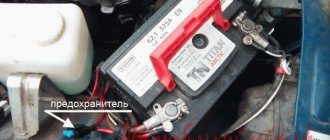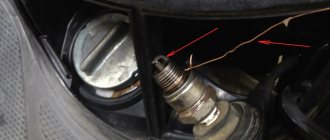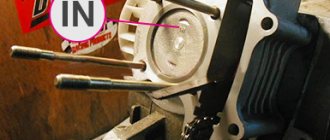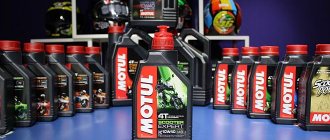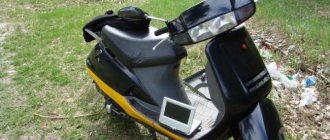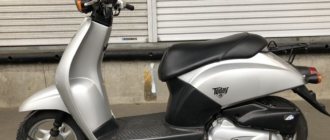Why does my scooter smoke?
Any scooter owner faces various strange faults or defects and one of the most asked questions is heavy smoke coming from the exhaust pipe of your scooter.
If you notice strong and thick smoke, do not despair and do not panic - a similar problem happens with absolutely every scooter. But be vigilant and if your exhaust pipe is emitting very thick and strong smoke, be alert and learn more about this problem, which has many factors behind it.
The first reason for thick smoke is the process after which you add oil to gasoline. Usually scooter owners do this after replacing the cylinder-piston group, so don't be afraid of this process, it's quite normal. But this is not the only case when a scooter smokes without malfunctions. The second point is the fact that any two-stroke scooter smokes. The fact is that the system of such a scooter is that oil is burned along with gasoline. That is, in any case, it ends up in the piston group and, accordingly, after the oil burns, thick smoke comes out. You must have noticed this process more than once on almost all Japanese scooters.
Worn piston group
But in any case, the smoke should not be too strong, so let’s consider the main reasons that answer the question: why does a two-stroke scooter smoke ?
Why does smoke come from the exhaust pipe on a 4-stroke scooter?
Four-stroke scooters are very different from two-stroke scooters in their design, so they have a completely different fuel and oil handling mechanism. If you regularly notice that your scooter is smoking every time, be wary and try to correct the cause of the smoke. The mechanism of a 4-stroke scooter is made in such a way that the poured oil accumulates in a special bath, which sends it in the required quantity to the piston group. In case of frequent smoke, try to remove the piston group and look at the piston. On such scooters, an oil scraper ring is installed on the piston, and it is this ring that can allow oil to pass into the exhaust. Replace the ring, its cost is quite insignificant.
In principle, we have examined the main reasons for scooter smoke; there are, of course, a number of other reasons, but we will not go into this. If you have questions about your scooter or want to share the reason for repairing this problem, write about it in the comments.
Source
Silencer for walk-behind tractor - manufacturing, shoots, flames, video
When a problem-free walk-behind tractor begins to act up, the owner falls into a kind of stupor and begins to look for the cause of the problems. The appearance of such a situation is doubly annoying when there is a lot of work and there is no time for downtime.
Often, troubles arise with the muffler, which, for certain reasons, begins to make strange sounds or even behave suspiciously. The main thing is not to panic, but to deal with everything with a cool mind. Let's get acquainted with several problems that occur most often.
The walk-behind tractor shoots into the muffler: what to do?
The owner of such useful and multifunctional equipment needs to know that interruptions in the operation of the muffler can occur due to:
- thin and low-quality metal;
- frequent potholes;
- excessive loads;
- difficult work;
- fastenings of an ill-conceived plan.
Often the cause of popping noises in the muffler are gaps in the process of supplying sparks and spark plugs. To get rid of the problem, you need to unscrew the spark plug, combine its body and mass, turning the crankshaft using the existing starting handle.
At the same time, you should pay attention to whether a spark appears. If even after these manipulations the situation does not change, it is advisable to thoroughly clean the spark plug.
Flame from the muffler of a walk-behind tractor and black smoke: looking for the cause and solution
Many experts believe that such problems arise due to incomplete combustion of fuel in the unit. It is possible that a misfire, the use of an overly rich mixture, a drop in power or overheating may be detected.
If, after trying to start work, not only a flame appears, but also black smoke, then we are talking about the use of low-quality oil or seriously contaminated injectors. Naturally, it is advisable to purchase a higher quality lubricant and thoroughly clean the injectors of all excess.
When a muffler, in addition to the indicated points, also produces serious noise, and a person wants to make it quiet, then it is necessary to increase the weight of the parts, because such problems often arise due to the lightness of the components.
You can get acquainted with other problems that arise with silencers Neva, Centaur, Garden Scout, etc., as well as their solutions, thanks to the video below, where a specialist presents everything in an accessible way and gives answers to the most frequently asked questions.
The 4-stroke engine of a Chinese scooter smokes
The 4-stroke engine (139qmb) of a Chinese scooter smokes heavily and a possible reason is rings or oil seals
I didn’t want to disassemble the piston on the 139qmb Super Sport Acar scooter but I had to. An attempt to fix it by adjusting the carburetor did not lead to anything, and the thick blue smoke at speed and the smell of burnt oil said that the whole problem was in the piston or valve stem seals. To my great pleasure, removing the cylinder on a 139qmb scooter engine is not a long process and after half an hour I I looked with surprise at the internal view of the piston group and head.
The piston turned out to be 47 mm in diameter, which generally pleased me. Extra personalities are never superfluous. There were a lot of surprises. After removing the head, it turned out to be a damaged piston bottom and a coked exhaust valve cap. After removing the cylinder and piston, the picture became completely clear.
The upper compression ring is in critical condition. The gap at the joint was within 5 mm. The oil scraper did not seem to work at all, because it did not extend beyond the groove, although it cannot be called stuck either. The wear on the cylinder mirror was visible to the naked eye.
It is necessary to change the piston group assembly. But there was no store nearby with spare parts, and buying online could take a long time. I decided (for now...) to make do with my own means. At home I found new rings from the Druzhba 4M chainsaw - 48 mm in diameter (on the engine ( 139qmb ) of the scooter - 47 mm) and began to adjust them. The scooter's second compression ring was in acceptable condition. The first one was made from “Druzhbinsk”, grinding down to almost twice the thickness. We also had to reduce the ring circumference by three millimeters, ensuring that the ring in the middle part of the cylinder had a gap at the joint of about 0.15 mm. The oil scraper ring was also made from “Druzhbinsky”. The width of it exactly matched the groove of the piston. It just had to be reduced in circumference and side grooves made for excess oil. The version is experimental and requires testing in action.
On the left are the new “friendship” rings, on the right they are adjusted for the scooter. The disadvantage of such modernized rings is that they do not match the geometry of the cylinder, because they are designed for a diameter of 48 mm and require time to break in. After installation, the engine continued to smoke, but to a much lesser extent.
Source
conclusions
If your 2 or 4 stroke scooter suddenly starts smoking, read this article again, diagnose the problem, repair it and enjoy your ride.
The 4-stroke engine (139qmb) of a Chinese scooter smokes heavily and a possible reason is rings or oil seals
I didn’t want to disassemble the piston on the 139qmb Super Sport Acar scooter but I had to. An attempt to fix it by adjusting the carburetor did not lead to anything, and the thick blue smoke at speed and the smell of burnt oil said that the whole problem was in the piston or valve stem seals. To my great pleasure, removing the cylinder on a 139qmb scooter engine is not a long process and after half an hour I I looked with surprise at the internal view of the piston group and head. The piston turned out to be 47 mm in diameter, which generally pleased me. Extra personalities are never superfluous.
There were a lot of surprises. After removing the head, it turned out to be a damaged piston bottom and a coked exhaust valve cap. After removing the cylinder and piston, the picture became completely clear.
The upper compression ring is in critical condition. The gap at the joint was within 5 mm. The oil scraper did not seem to work at all, because it did not extend beyond the groove, although it cannot be called stuck either. The wear on the cylinder mirror was visible to the naked eye.
It is necessary to change the piston group assembly. But there was no store nearby with spare parts, and buying online could take a long time. I decided (for now...) to make do with my own means. At home I found new rings from the Druzhba 4M chainsaw - 48 mm in diameter (on the engine ( 139qmb ) of the scooter - 47 mm) and began to adjust them. The scooter's second compression ring was in acceptable condition. The first one was made from “Druzhbinsk”, grinding it down to almost twice the thickness. We also had to reduce the ring circumference by three millimeters, ensuring that the ring in the middle part of the cylinder had a gap at the joint of about 0.15 mm. The oil scraper ring was also made from Druzhbinsky. The width of it exactly matched the groove of the piston. It just had to be reduced in circumference and side grooves made for excess oil. The version is experimental and requires testing in action.
On the left are the new “friendship” rings, on the right they are adjusted for the scooter. The disadvantage of such modernized rings is that they do not match the geometry of the cylinder, because they are designed for a diameter of 48 mm and require time to break in. After installation, the engine continued to smoke, but to a much lesser extent.
PS Subsequently, I finally found a standard set of rings for a 139qmb D=47mm engine in one of the stores, and after installing it, the problem with engine smoke disappeared. Oil consumption has also decreased accordingly.
Source
2 stroke scooters
It’s worth noting right away that two-stroke engines will always smoke. The whole point is the principle of operation of a 2-stroke engine. Recalling the theory of engine operation, let's say that unlike a 4-stroke internal combustion engine, where oil is poured into the crankcase, on a 2-stroke engine the lubrication process occurs differently.
These engines have a dry sump and are internally lubricated by adding oil to the fuel. On scooters, a separate oil tank is installed, or a ready-made mixture of gasoline and oil is poured into the gas tank. The constant presence of oil in the combustion chamber of the engine provides smoke from the exhaust pipe.
GENERAL CHARACTERISTICS OF THE PROBLEM
If your motorcycle is in good working order, then the exhaust is nothing more than a combination of water and carbon dioxide. Without impurities and additional components. However, in the case of fuel combustion, we are not dealing with pure oxygen, but with diluted nitrogen.
The color of smoke from a motorcycle muffler can be different: white, black and even blue. By its shade we are able to determine the nature of the breakdown. Often, smoke appears with other signs of malfunctions that are not noticed at first. This is the first sign that a serious breakdown is soon possible. And it needs to be excluded.
The problem is that even the most modern motorcycles experience incomplete combustion and oxidation of fuel. Accordingly, more CO and CH come out. Because of this, when changing fuel, a change in the color and consistency of exhaust smoke may be observed. In addition, sometimes oil or coolant used gets into the combustion chamber, which gives off its chemical compounds and is thrown out.
Another common cause is the wear and tear of the filter system. No matter how carefully you treat your motorcycle, filters perform their functions worse and worse over time. Therefore, if changes in the color of the exhaust are observed, perhaps replacing the filters will be the simplest solution to the problem. However, the matter may be completely different. Let's consider different options and possibilities for solving the problem.
JavaScript is disabled in your browser
If you often observe smoke from the exhaust pipe of your scooter, then before you panic, remember what engine is installed on your device. Two-stroke or four-stroke?
Two-stroke smokes
However, even such scooters should not “smoke” too much. If you notice that your scooter is smoking excessively, there may be several reasons for this. Firstly, you should definitely check the oil pump; if configured incorrectly, more oil may pass through it than necessary. Secondly, check the piston. A worn piston is one of the main causes of excessive smoking. First of all, check the rings. If the rings are worn out, then the compression may not be strong enough in the cylinder, as a result of which the fuel mixture simply does not burn out.
The spark plug should also be replaced if necessary. A faulty spark plug can cause misfire, which will also cause heavy smoke from the exhaust pipe. Sometimes simply replacing the air filter is enough. If it is clogged, the engine will not have enough air to completely burn all the mixture in the cylinder. Another reason for heavy smoke from the exhaust pipe may be a mixture that is too rich. If the mixture is very rich, the air will burn, but the fuel will still remain. In some engines, such as upright Honda scooter engines, when the oil seal leaks, oil can accumulate in the crankcase, which will certainly burn when the engine starts and warms up, generating a lot of thick black smoke. Maybe you just added too much oil to the gasoline. This is usually done when running in and traveling long distances. In this case, there is no need to worry. Also, during long trips at low speeds, oil can accumulate in the muffler, which then burns out when the owner gives gas.
Four-stroke smokes
If your scooter has a four-stroke engine and you notice thick black smoke, you should be wary. It is important to understand that, unlike a two-stroke system, the oil in a four-stroke engine is in a special oil bath, which is in no way connected to the combustion chamber. They are separated by a special oil scraper ring. Its wear or accumulation is the most common cause of smoke in a four-stroke engine. So, if it gets stuck or wears out, some of the oil gets into the combustion chamber and is burned there, which should not happen with “four-stroke” engines. Naturally, this breakdown must be corrected immediately. In addition, as with a two-stroke engine, smoking can be caused by: a clogged air filter, a faulty spark plug and worn piston rings.
BLUE SMOKE
Oil getting into the cylinders is the most common reason for its regular appearance. The smoke itself can have a whole range of different tones: from unclouded bluish to a rich bluish tint. The blue smoke does not immediately dissipate in the air, and when performing a test with a piece of paper, dirty, oily droplets are left on it, which come out along with the exhaust gases. There are several key reasons for the blueness of smoke:
- Damage to valve stems, guide bushings and wear of valve stem seals. They noticeably increase the amount of smoke while the engine warms up.
- Excessive oil consumption is observed in engines that have a turbocharger. Cause: A faulty turbocharger, which you will most likely need to replace.
- Malfunctions of the ventilation system. Its task is to separate the oil and adjust the flow rate. It needs to be reconfigured or replaced.
- When blue smoke appears from the muffler, you must closely monitor the oil level so that it is normal, and be sure to monitor the serviceability and suitability of the piston group parts.
If you notice that oil is being consumed faster than usual, this is a clear sign of a ventilation problem. The cost of replacement is low, so there is little point in repairing it. It's easier to buy.
Troubleshooting
If the scooter is smoking, you can fix it yourself with your hands growing from the right place. So, let's start the renovation.
Rich mixture
A rich mixture means that the carburetor is supplying little gasoline and a lot of air to the cylinder. To adjust this ratio, a quality screw is used . To establish the optimal ratio, you need to unscrew this screw, thereby adding air and reducing gasoline in the ratio.
The quality of the fuel mixture is adjusted using a screwdriver and the quality screw on the carburetor. Source: 49ccscoot.com
The optimal value is set experimentally once normal operation of the internal combustion engine is achieved. Normal operation is characterized by the absence of increased emissions and normalization of the traction characteristics of the scooter.
Advice! If you drove with a rich mixture, be sure to clean the spark plug or replace it with a new one. With the spark plug removed, crank the engine with the starter so that the piston pushes the excess out of the cylinder.
Bad oil
After changing the oil, a 4-stroke scooter may smoke. This happens when low viscosity oil is poured into the engine. For example, synthetic oil is less viscous than semi-synthetic or mineral oil, meaning it is thinner. Such oil seeps into those gaps where the more viscous oil gets stuck.
Therefore, even with little wear on the piston group, oil can enter the exhaust and smoke there. Replacing the oil with a thicker one eliminates this problem. If you stubbornly want to drive with just such oil, then you should do a major overhaul of the piston.
How to Find and Fix Engine Smoke Problems
If you want to troubleshoot a small engine yourself and repair it.
- Step 1: Are you tilting the engine or running it at an angle greater than 15 degrees? Leaning the mower or equipment may cause leakage. Level the car before proceeding.
- Step 2: Checking and changing the oil is an easy way to fix such problems. Check to see if the oil is overfilled or if you are using the wrong grade/type of oil.
- Step 3: Check the crankcase for leaks.
- Step 4: Is the cylinder head gasket blown?
- Step 5: Are the rings and/or cylinder worn?
Why does my scooter smoke?
Any scooter owner faces various strange faults or defects and one of the most asked questions is heavy smoke coming from the exhaust pipe of your scooter.
If you notice strong and thick smoke, do not despair and do not panic - a similar problem happens with absolutely every scooter. But be vigilant and if your exhaust pipe is emitting very thick and strong smoke, be alert and learn more about this problem, which has many factors behind it.
The first reason for thick smoke is the process after which you add oil to gasoline. Usually scooter owners do this after replacing the cylinder-piston group, so don't be afraid of this process, it's quite normal. But this is not the only case when a scooter smokes without malfunctions. The second point is the fact that any two-stroke scooter smokes. The fact is that the system of such a scooter is that oil is burned along with gasoline. That is, in any case, it ends up in the piston group and, accordingly, after the oil burns, thick smoke comes out. You must have noticed this process more than once on almost all Japanese scooters.
Worn piston group
But in any case, the smoke should not be too strong, so let’s consider the main reasons that answer the question: why does a two-stroke scooter smoke ?
WHITE SMOKE
In most cases, white smoke is a common occurrence in winter when you warm up your motorcycle in the morning. And almost always it is not smoke, but ordinary steam. Due to the temperature difference in the exhaust pipe, condensation always forms when it cools, after which it freezes until the next time the motorcycle warms up. When you start the car, the exhaust pipe also begins to heat up, melting the frozen condensate and turning it into a gaseous state. In this case, water may also drip from the pipe, which is also not a serious problem in this case. And the colder it is outside, the more noticeable the smoke is. Yes, and humidity plays a role. The higher it is, the thicker the white steam.
But what to do when the exhaust of an unusual color from the muffler is observed non-stop even in warm summer weather? This phenomenon is primarily associated with the penetration of liquid into the cylinders. As a rule, these are coolers: antifreeze, antifreeze or even plain water. In this case, there is a chance that you need to replace the cylinder head gasket. The moisture does not evaporate completely and smoke with a high density is formed. Characteristic is the fact that the color and density of the exhaust can vary greatly depending solely on the type of coolant. Low quality and cheap in itself can cause a lot of trouble.
In order to better understand the nature of white smoke, you need to carry out diagnostics. It mainly occurs due to problems in the cooling system. If there is a hint of its malfunction, we strongly recommend that you carry out a series of checks. First of all, you should make sure that the liquid is evaporating from the muffler. Warm up the engine to its usual operating temperature (the procedure can be carried out even after some travel). Find a clean piece of paper and apply it to the pipe, partially blocking the hole with it.
We draw conclusions: if it is water, it will turn into steam, without leaving behind any greasy, oily traces; if there are greasy stains on the sheet, there is clearly a problem in the system.
If the sheet is clean, we continue the search. The problem of moisture ingress may lie not in the gasket itself, which due to certain factors was damaged, but also in cracks in the cylinder blocks. They can usually be detected without problems upon careful examination.
There is another fairly common reason for the appearance of white smoke - the engine does not have time to warm up. If you drive a little and over short distances, condensation accumulates more and more and does not have time to escape. As a result, the exhaust may become so clogged with condensate that the car simply will not start. To avoid this, we recommend that you fully warm up the motorcycle at least once a day, and if possible, use auto-warming.
But detected problems, which are accompanied by white smoke from the muffler, do not just require urgent elimination of their causes. They require careful inspection and elimination of defects in the cooling system, since, as practice shows, they are caused by engine overheating. There is a possibility that the thermostat is faulty or the switch is not working, the radiator is not sealed, etc.
To summarize, we can say that in winter you should not particularly focus on the appearance of white smoke. The problem solves itself with the arrival of heat without your participation.
Engine Features
Two-stroke scooters tend to burn oil along with gasoline. Therefore, every two-stroke scooter will smoke, because the oil burns anyway. Japanese two-stroke scooters often smoke, as you may have noticed more than once. But what makes the difference is how much smoke your scooter will produce.
Reasons why a 2-stroke scooter smokes:
smoke from a japanese scooter
If you notice this on your 2-stroke scooter, do not worry, because this is almost a standard phenomenon that occurs with all engines.
Overheat.
Plug Type: Extremely white insulator with small black flecks and premature electrode erosion.
Consequences: loss of scooter power at high speed or under load.
Probable causes: the spark plug is not screwed in enough; The scooter's engine cooling system is not working properly; ignition of the scooter too early; The thermal range is incorrectly selected - the candle is too “hot”.
Remedy: check the torque of the scooter's spark plug; operation of the scooter engine cooling system; adjust the ignition timing; select the correct spark plug heat rating.
Type of spark plug: melted and burned central and grounding electrodes (or one of the electrodes) of the scooter spark plug; bubbling insulator with metal deposits on it.
Consequences: significant loss of scooter engine power; ignition interruptions. Continued use of such spark plugs may cause serious damage to the scooter engine.
Probable causes: thermal overload; significant overheating of spark plug parts due to glow ignition - combustion begins before a proper ignition spark appears; use of low-quality fuel; burning out of the remaining air-fuel mixture in the combustion chamber due to an incorrectly adjusted fuel system of the scooter or the ignition timing of the scooter; The thermal range is incorrectly selected - the spark plug is too “hot”.
Remedy: check the scooter engine, ignition system and fuel system, as well as the quality of the working mixture and the ignition timing of the scooter. Install new spark plugs with the correct heat rating.
Source
2 stroke scooters
It’s worth noting right away that two-stroke engines will always smoke. The whole point is the principle of operation of a 2-stroke engine. Recalling the theory of engine operation, let's say that unlike a 4-stroke internal combustion engine, where oil is poured into the crankcase, on a 2-stroke engine the lubrication process occurs differently.
These engines have a dry sump and are internally lubricated by adding oil to the fuel. On scooters, a separate oil tank is installed, or a ready-made mixture of gasoline and oil is poured into the gas tank. The constant presence of oil in the combustion chamber of the engine provides smoke from the exhaust pipe.
However, if the scooter smokes heavily, this indicates a malfunction. At best, the driver poured too much oil into the gasoline. In other cases, the reason lies deeper in the engine. These reasons are similar to a 4-stroke engine, so let’s consider them using the example of such an internal combustion engine.
Signs that require an urgent check of the carburetor
Most motorists know the principle of operation of the carburetor unit and the necessary conditions for its stable operation. The main indicator for the full functioning of the engine is the composition of the combustible mixture, which should consist of 15 parts air and 1 part gasoline. Violation of the ratio leads to enrichment or, conversely, to depletion of the composition.
The main signs of a lean mixture:
- instability XX;
- difficult starting;
- popping sounds in the carburetor;
- the engine does not gain momentum;
- white carbon deposits on the candle.
Signs of over-enrichment of the combustible mixture:
- increased fuel consumption;
- candle covered in soot;
- popping sounds in the exhaust pipe;
- slow acceleration.
JavaScript is disabled in your browser
If you often observe smoke from the exhaust pipe of your scooter, then before you panic, remember what engine is installed on your device. Two-stroke or four-stroke?
Two-stroke smokes
However, even such scooters should not “smoke” too much. If you notice that your scooter is smoking excessively, there may be several reasons for this. Firstly, you should definitely check the oil pump; if configured incorrectly, more oil may pass through it than necessary. Secondly, check the piston. A worn piston is one of the main causes of excessive smoking. First of all, check the rings. If the rings are worn out, then the compression may not be strong enough in the cylinder, as a result of which the fuel mixture simply does not burn out.
The spark plug should also be replaced if necessary. A faulty spark plug can cause misfire, which will also cause heavy smoke from the exhaust pipe. Sometimes simply replacing the air filter is enough. If it is clogged, the engine will not have enough air to completely burn all the mixture in the cylinder. Another reason for heavy smoke from the exhaust pipe may be a mixture that is too rich. If the mixture is very rich, the air will burn, but the fuel will still remain. In some engines, such as upright Honda scooter engines, when the oil seal leaks, oil can accumulate in the crankcase, which will certainly burn when the engine starts and warms up, generating a lot of thick black smoke. Maybe you just added too much oil to the gasoline. This is usually done when running in and traveling long distances. In this case, there is no need to worry. Also, during long trips at low speeds, oil can accumulate in the muffler, which then burns out when the owner gives gas.
Four-stroke smokes
The starter screams, the cord comes out
- May scream if there is a lot of lube on the balls. It is necessary to clean the balls and the places in the ratchet where they are inserted.
The cultivator released several pops and began to “float”
- Most likely, the power system is not coping, or the fuel level in the tank is low, the float axis may be skewed and perhaps there is debris under the needle valve, you need to remove everything and check the air filter, jets.
The material will be updated, we will be waiting for questions, stories about the detection of a particular malfunction and ways to eliminate it. Also see Answers to questions about a particular walk-behind tractor model on its description page.
Is your engine running but emitting white or blue smoke? Learn what can cause white smoke in your engine and how to fix it.
! Always read the engine and equipment manual(s) before starting, operating, or servicing the engine or equipment to avoid personal injury or property damage. See your authorized dealer or contact Briggs & Stratton if you are unsure of any procedure or have additional questions. Find all engine hazard warnings
Diagnostics
Let's determine which of the faults is present in your case. Much can be determined by the color of the smoke. For example, if the smoke is black, then the reason lies in a rich air-fuel mixture. A possible cause is an incorrect ignition angle. If the fuel mixture does not burn completely, its residues end up in the exhaust during the next engine stroke.
The blue color of the smoke characterizes the entry of engine oil into the combustion chamber. The reason for this may be worn or stuck oil scraper rings. Also, complete wear of the piston group entails increased smoke emissions and reduced thrust. Valves or valve seals that are in poor condition also produce unnatural smoke from the exhaust pipe.
For liquid-cooled engines with characteristic white smoke from the chimney, the cause is a blown cylinder head gasket . Coolant passes through the gasket rupture and enters the combustion chamber or exhaust.
Causes of excessive smoke in a 4-stroke
Unnatural smoke from the exhaust pipe of a moped or scooter can be caused by a number of problems. Among them:
- Fuel mixture too rich
- Wear of the piston group or oil scraper wheels
- Problems with valves and their seals
- Engine oil
- Cylinder head gasket
Troubleshooting
If the scooter is smoking, you can fix it yourself with your hands growing from the right place. So, let's start the renovation.
Rich mixture
A rich mixture means that the carburetor is supplying little gasoline and a lot of air to the cylinder. To adjust this ratio, a quality screw is used . To establish the optimal ratio, you need to unscrew this screw, thereby adding air and reducing gasoline in the ratio.
The quality of the fuel mixture is adjusted using a screwdriver and the quality screw on the carburetor. Source: 49ccscoot.com
The optimal value is set experimentally once normal operation of the internal combustion engine is achieved. Normal operation is characterized by the absence of increased emissions and normalization of the traction characteristics of the scooter.
Advice! If you drove with a rich mixture, be sure to clean the spark plug or replace it with a new one. With the spark plug removed, crank the engine with the starter so that the piston pushes the excess out of the cylinder.
Bad oil
After changing the oil, a 4-stroke scooter may smoke. This happens when low viscosity oil is poured into the engine. For example, synthetic oil is less viscous than semi-synthetic or mineral oil, meaning it is thinner. Such oil seeps into those gaps where the more viscous oil gets stuck.
Therefore, even with little wear on the piston group, oil can enter the exhaust and smoke there. Replacing the oil with a thicker one eliminates this problem. If you stubbornly want to drive with just such oil, then you should do a major overhaul of the piston.
Why does my scooter smoke?
Any scooter owner faces various strange faults or defects and one of the most asked questions is heavy smoke coming from the exhaust pipe of your scooter.
If you notice strong and thick smoke, do not despair and do not panic - a similar problem happens with absolutely every scooter. But be vigilant and if your exhaust pipe is emitting very thick and strong smoke, be alert and learn more about this problem, which has many factors behind it.
The first reason for thick smoke is the process after which you add oil to gasoline. Usually scooter owners do this after replacing the cylinder-piston group, so don't be afraid of this process, it's quite normal. But this is not the only case when a scooter smokes without malfunctions. The second point is the fact that any two-stroke scooter smokes. The fact is that the system of such a scooter is that oil is burned along with gasoline. That is, in any case, it ends up in the piston group and, accordingly, after the oil burns, thick smoke comes out. You must have noticed this process more than once on almost all Japanese scooters.
Worn piston group
But in any case, the smoke should not be too strong, so let’s consider the main reasons that answer the question: why does a two-stroke scooter smoke ?
Why does smoke come from the exhaust pipe on a 4-stroke scooter?
Four-stroke scooters are very different from two-stroke scooters in their design, so they have a completely different fuel and oil handling mechanism. If you regularly notice that your scooter is smoking every time, be wary and try to correct the cause of the smoke. The mechanism of a 4-stroke scooter is made in such a way that the poured oil accumulates in a special bath, which sends it in the required quantity to the piston group. In case of frequent smoke, try to remove the piston group and look at the piston. On such scooters, an oil scraper ring is installed on the piston, and it is this ring that can allow oil to pass into the exhaust. Replace the ring, its cost is quite insignificant.
In principle, we have examined the main reasons for scooter smoke; there are, of course, a number of other reasons, but we will not go into this. If you have questions about your scooter or want to share the reason for repairing this problem, write about it in the comments.

